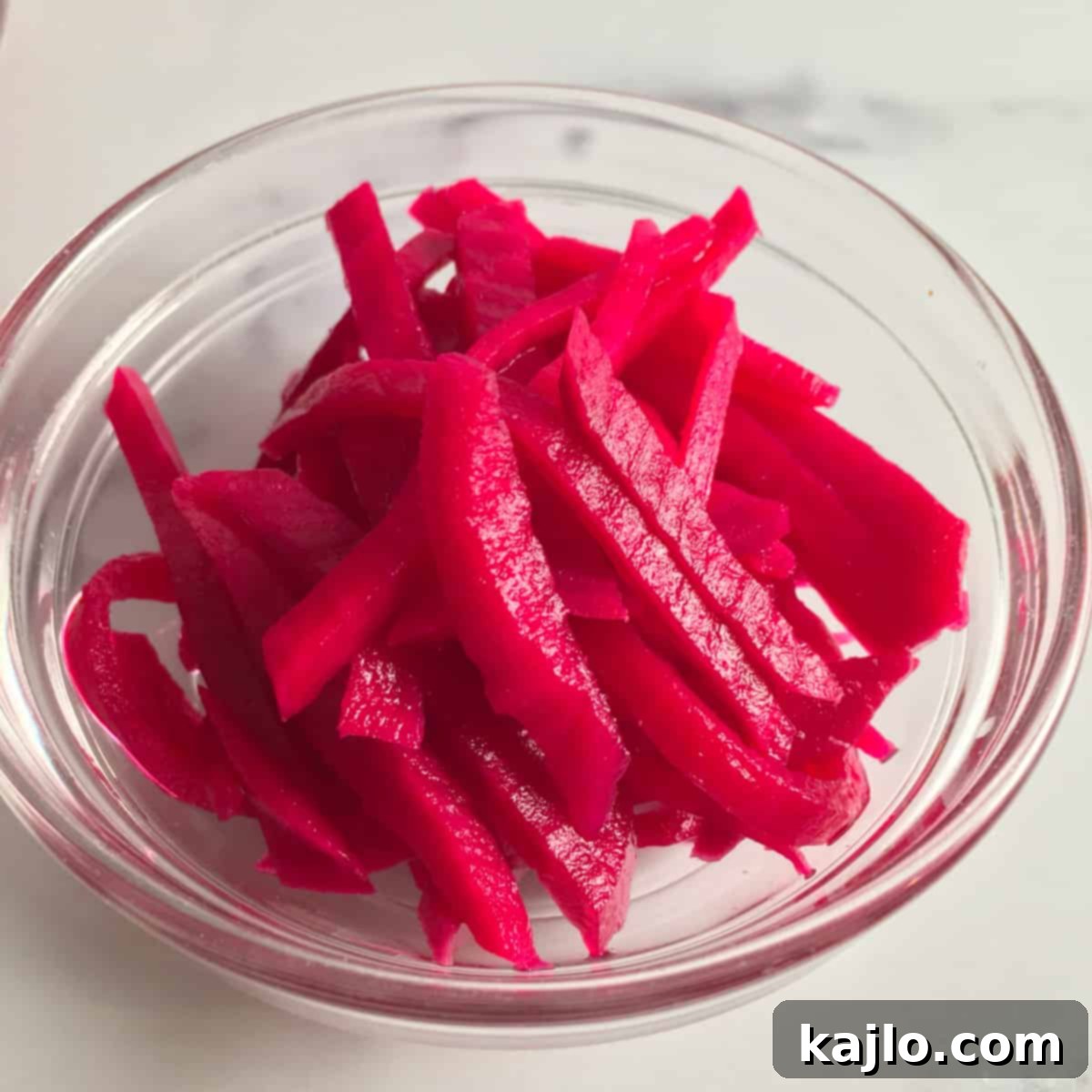Discover the Secret of Shawarma: Mastering Authentic Lebanese Pink Pickles
Ever wondered about those vibrant, tangy pink pickles that elevate your shawarma experience? These delightful condiments, a staple in Middle Eastern cuisine, are actually **Lebanese pickled turnips**! Dive into the art of making your very own **Middle Eastern pickles** with this easy-to-follow **shawarma pickles recipe**. Not only are these **Lebanese pickled vegetables** naturally vegan, gluten-free, and low-carb, but their captivating color and zesty flavor will transform your wraps, sandwiches, and countless other dishes. Get ready to add a gourmet touch to your homemade meals!
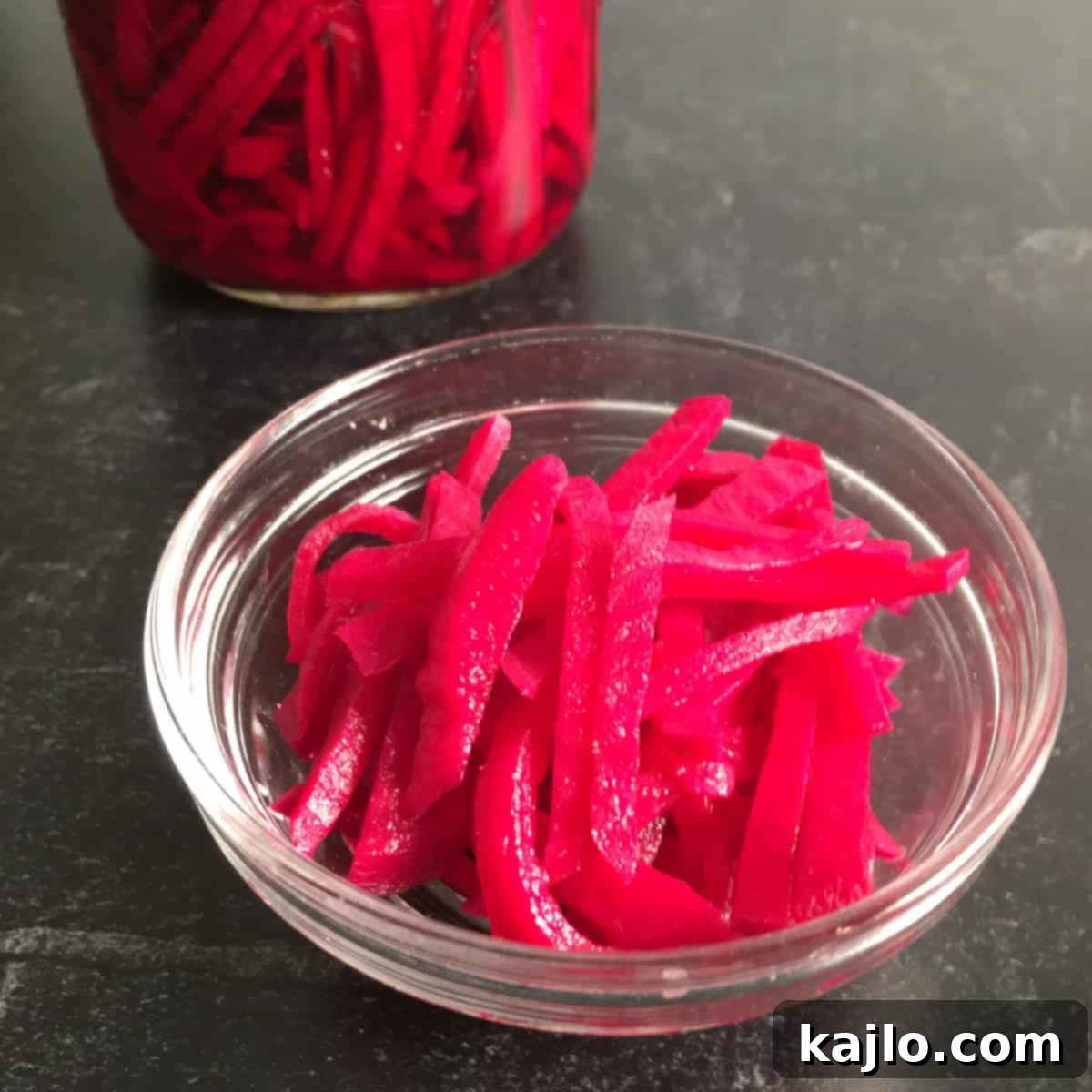
Beyond the Cucumber: Exploring the Diverse World of Pickles
When most people hear the word “pickle,” their minds immediately conjure images of crunchy green cucumbers brined in dill. However, the world of pickling is vast and incredibly diverse, extending far beyond this popular favorite. Vegetables like eggplant, green beans, onions, and okra are all excellent candidates for pickling, each offering a unique texture and flavor profile when preserved. This ancient method of food preservation not only extends shelf life but also enhances the natural flavors of vegetables, often adding a delightful tang or a spicy kick.
For many years, I, like countless others, mistakenly assumed the strikingly pink pickles often found nestled in a delicious shawarma wrap were simply red onions. While red onions can indeed be pickled and offer a lovely color, the distinct brightness and sharp, earthy flavor of these particular **Lebanese pink pickles** always hinted at something more intriguing. Their unmistakable zest and vibrant hue set them apart, sparking a curiosity that led to uncovering their true identity.
Unraveling the Mystery: What Makes Shawarma Pickles Pink?
So, what exactly **kind of pickles are in shawarma?** And what’s the secret behind their iconic pink color? The answer lies in a simple yet ingenious combination of everyday vegetables: turnips and beets. That’s right, the secret ingredient imparting that signature rosy glow to **Lebanese shawarma pickles** is a small amount of beet! This root vegetable, known for its intense pigment, naturally dyes the entire batch of pickles a beautiful pink as they steep in the brine.
Today, we’re diving deep into the fascinating world of these flavorful condiments. You’re about to learn everything you need to know to create the perfect tangy topping for your next meal, whether it’s a succulent air fryer chicken shawarma, a falafel platter, or a simple hummus spread. A friendly warning before you begin: these pickles are incredibly addictive! You might find yourself snacking on them straight from the jar, they’re that good!
🥒 What Are Authentic Lebanese Pickles?
Authentic **Lebanese pickles** for shawarma are primarily a mixture of crisp turnips, vibrantly colored by a small addition of beets. While traditional methods may involve natural fermentation, this recipe focuses on a quicker method using a vinegar brine, allowing you to enjoy homemade pickles sooner.
The beauty of these pickles lies in their balance: predominantly turnips for that characteristic sharp, peppery bite, with just enough beet to impart a stunning, even pink hue to all the vegetables. When packed tightly in a jar with an acidic brine (like vinegar), the beet’s natural pigments leach out, transforming the turnips and the liquid into a captivating shade of pink. After the pickling process, the turnips and beets become so integrated in color and flavor that it’s often hard to distinguish them visually, offering a delightful surprise in every bite.
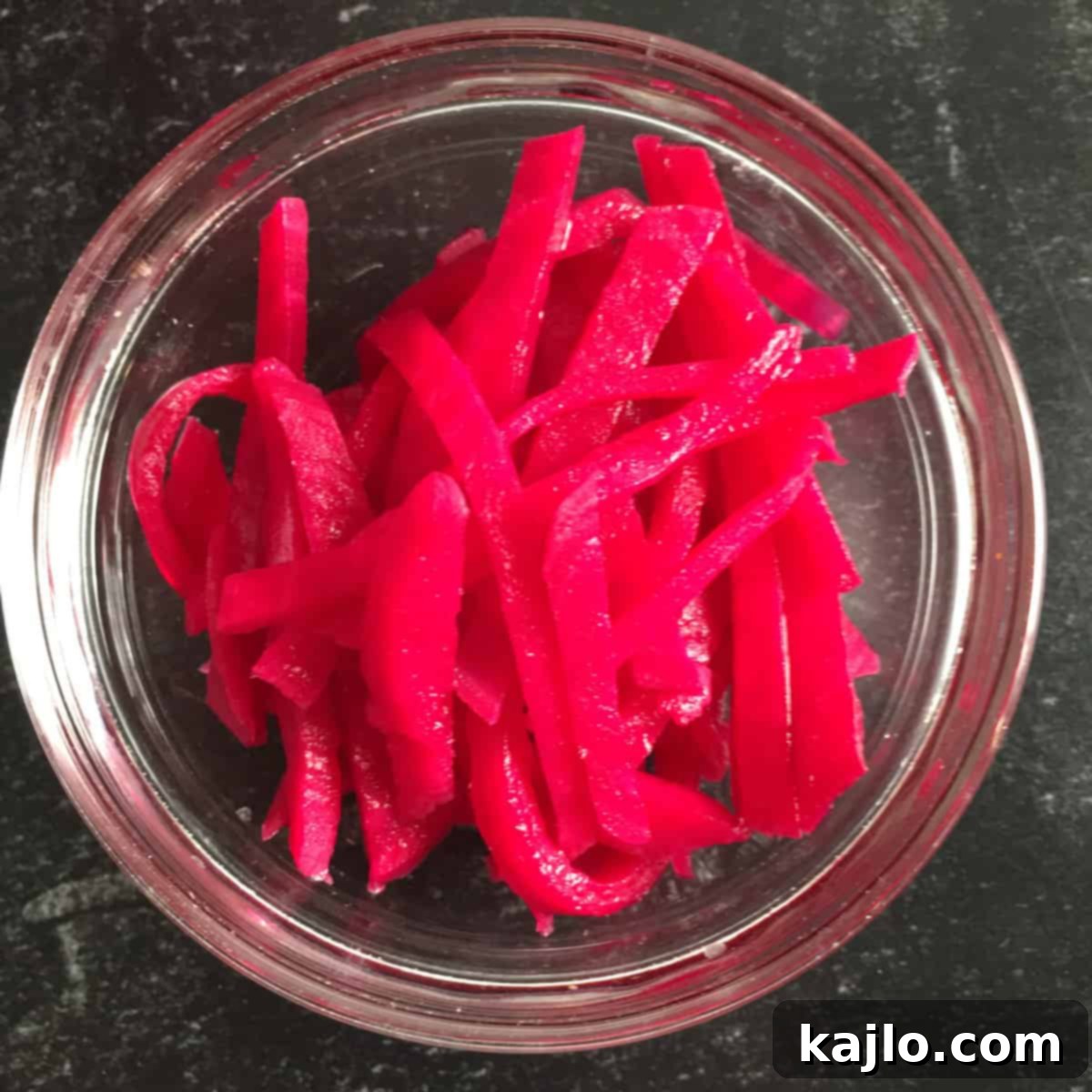
⭐ The Multifaceted Benefits of Lebanese Pickles
Beyond their irresistible taste and striking appearance, making **Middle Eastern Pickles** offers a wealth of benefits:
- Boost Your Gut Health: While store shelves are typically stocked with cucumber pickles and sauerkraut, the variety of other fermented vegetables is often limited. By making your own, you can significantly broaden the spectrum of fermented foods in your diet, which is fantastic for promoting a diverse and healthy gut microbiome. Naturally fermented beets and turnips, in particular, introduce beneficial probiotics, supporting digestive wellness.
- Nutrient-Rich Addition: These vibrant pink pickles are more than just a flavor enhancer; they’re packed with essential nutrients. Turnips and beets contribute a good source of vitamin C, potassium, and dietary fiber to your meals. If you opt for natural fermentation (using only salt, without vinegar), these vegetables also become a fantastic source of live probiotics, further amplifying their health benefits.
- Incredible Versatility: The tangy, savory, and slightly sweet notes of Lebanese pickles make them an incredibly versatile condiment. Use them to brighten up a fresh salad, add depth to a grain bowl, or provide a zesty counterpoint to a juicy burger. They are, of course, absolutely indispensable with classic Mediterranean dishes like falafel wraps, savory gyros, succulent shawarma, refreshing salads, or simply alongside creamy hummus and warm pita bread. Their unique flavor profile complements a wide array of cuisines.
- Effortlessly Simple to Make: Don’t be intimidated by the idea of making pickles from scratch! This recipe is surprisingly straightforward, requiring only a few basic ingredients: fresh vegetables, vinegar, and salt. These pantry staples are readily available in most major grocery stores, making homemade pickles an accessible culinary project for anyone.
- Accommodates Special Diets: For those with specific dietary needs, these pink pickles are a true gem. They are naturally vegan, gluten-free, dairy-free, and low-carb, making them an inclusive and delicious option for almost any family member. They provide a fantastic way to infuse meals with flavor and a gorgeous pop of color without compromising dietary restrictions.
- Simply Delicious: Ultimately, the most compelling reason to make this **Lebanese pickles recipe** is its unparalleled taste. Whether enjoyed as a tangy side dish, a zesty topping, or a refreshing snack straight from the jar, their unique flavor profile is guaranteed to delight your palate and become a new favorite in your kitchen.
🥘 Essential Ingredients for Middle Eastern Pickles
Crafting these delectable **Lebanese pickles** requires a handful of fresh, high-quality ingredients:
- Fresh Peeled Turnips: These are the star of the show, providing the signature crisp texture and slightly peppery, earthy flavor that defines Lebanese pickled turnips. Choose firm, blemish-free turnips for the best results.
- Fresh Peeled Beets: While used in a smaller quantity, beets are crucial for imparting that stunning, natural pink color to the pickles and the brine. They also add a subtle sweetness and depth of flavor.
- Garlic Clove: A single smashed garlic clove infuses the brine with a pungent, aromatic warmth, complementing the sharpness of the turnips beautifully.
- Water: The base of our pickling brine. Filtered water is often recommended to avoid any chlorine that might affect fermentation or flavor.
- White Vinegar: This provides the acidity necessary for quick pickling, giving the pickles their characteristic tangy bite and acting as a preservative. Distilled white vinegar is preferred for its neutral flavor.
- Finely Ground Sea Salt: Essential for both flavor and preservation. The type of salt used is important for successful pickling.
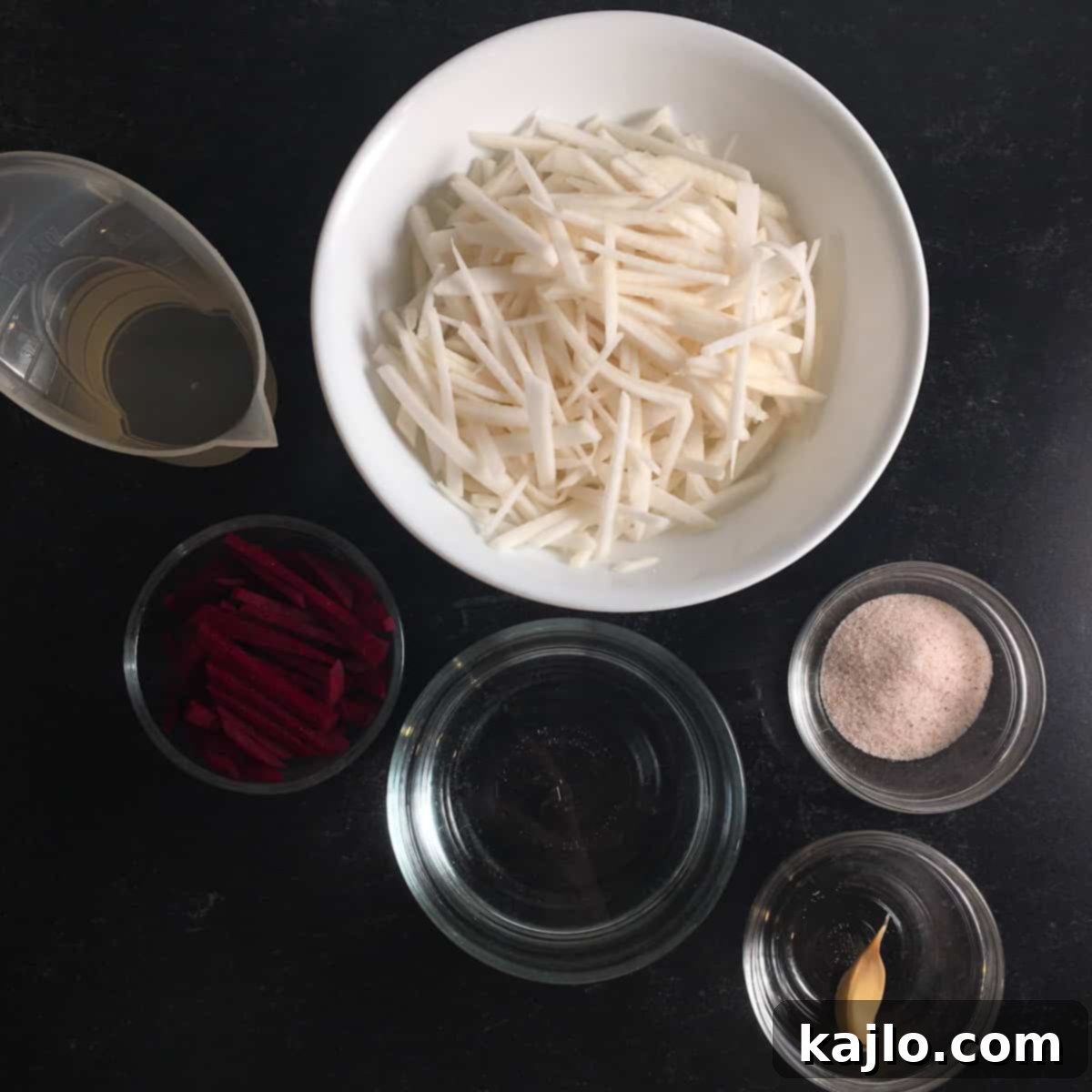
You’ll find the precise quantities for each ingredient in the detailed recipe card at the bottom of this article. For the best flavor and texture, always choose the freshest possible turnips and beets. Look for firm, heavy vegetables with smooth skins, free from soft spots or blemishes. The quality of your produce directly impacts the deliciousness of your homemade pickles.
Choosing the Right Salt for Pickling
Similar to making fermented cabbage like sauerkraut, the type of salt you use is critical for successful pickling. Always opt for canning salt, pickling salt, or a high-quality fine-grain sea salt. **Iodized salt is not recommended for this recipe**, as the anti-caking agents and iodine present in it can sometimes turn your pickles dark or result in a cloudy brine. For more detailed guidance, the USDA provides excellent resources on safe food fermentation.
While this recipe keeps the flavor profile pure and simple, feel free to customize it with additional aromatics. A few dried bay leaves, a pinch of mustard seeds, or some fresh dill sprigs can add wonderful layers of flavor, allowing you to personalize your **Middle Eastern pickles** to your taste preferences.
🍽 Essential Equipment for Crafting Lebanese Pickles
Achieving pickling success, especially for your first batch of homemade **Lebanese pickles**, is made easier with a few key pieces of kitchen equipment. Here’s what I highly recommend:
- Fermenting Kit with Jar Weights and Airlock Lids: While this recipe is for quick pickles (using vinegar), a fermenting kit can still be incredibly useful. Jar weights help keep your vegetables submerged beneath the brine, preventing spoilage. Airlock lids allow gases to escape during fermentation (if you were to try a natural salt-only ferment) while keeping unwanted air and contaminants out. Even for quick pickles, they provide an excellent seal and peace of mind.
- Wide-Mouth Quart Jar with Lid (Glass Mason Jar): These jars are ideal for pickling due to their wide opening, which makes packing vegetables and removing pickles much easier. They are also incredibly versatile for various kitchen storage needs, from dried legumes and grains to homemade Instant Pot yogurt. You can find them affordably at stores like Walmart, Target, or online platforms like Amazon.
- Good Knife: A sharp, sturdy knife is essential for safely and efficiently peeling and slicing your turnips and beets into uniform batons. Precision in cutting ensures even pickling and a pleasing presentation.
- Vegetable Peeler: A reliable vegetable peeler makes quick work of preparing your turnips and beets, removing their skins smoothly and effortlessly.
Importance of Sanitation
Before you begin the pickling process, it is paramount to properly sanitize all your equipment. This crucial step helps to prevent the growth of undesirable bacteria that could spoil your batch of pickles. You don’t necessarily need a boiling water bath for sterilization, as this quick pickle recipe does not involve canning or anaerobic fermentation, but a thorough wash with hot, soapy water followed by rinsing and air-drying or a dip in a sanitizing solution is highly recommended to ensure a clean start.
🔪 Step-by-Step Guide: How to Make Lebanese Pickles
Crafting your own batch of **homemade pink pickles** is a rewarding experience. Follow these simple steps to create perfectly tangy and crisp **pickled turnips and beets**:
Prepare the Vegetables: Begin by carefully peeling both your turnips and beets. Once peeled, slice them into very thin batons, often referred to as matchsticks. The thinner you cut them, the faster and more evenly they will pickle, absorbing the brine’s flavors and achieving a desirable texture. Aim for pieces that are almost shredded in appearance. Next, take your garlic clove and give it a good smash to release its potent aromas and flavors. Set these prepared vegetables aside while you move on to the next step of preparing the brine.
Create the Brine: In a small saucepan, combine the water, white vinegar, and finely ground sea salt. Place the saucepan on your stovetop over medium heat. Stir the mixture occasionally until the salt completely dissolves, creating a clear brine. This ensures an even distribution of saltiness and acidity throughout your pickles. Once dissolved, remove the saucepan from the heat and allow the brine to cool down for a few minutes. It doesn’t need to be completely cold, but it shouldn’t be boiling hot when poured over the vegetables.
Pack the Jar: Take your clean, wide-mouth quart jar and begin to tightly pack the prepared vegetables, including the smashed garlic clove, into it. It’s important to pack them down firmly but gently. Ensure that the vegetables remain below the shoulders of the jar, leaving enough space for the brine and a jar weight. If your vegetables don’t fit comfortably, it’s a sign they weren’t sliced thinly enough, and you might need to adjust their size or use an additional jar. Proper packing is key for even pickling.

Add Brine and Weight: Carefully pour the cooled brine over the packed vegetables in the jar. Make sure all the vegetables are completely submerged in the liquid. Once the brine is added, gently place the jar weight on top of the vegetables. The weight will help keep the vegetables below the liquid level, which is vital for successful pickling and preventing spoilage. Don’t worry if you don’t use all of the brine; having extra is better than not having enough.
Ensure Submersion and Seal: If necessary, press down on the jar weight to ensure all vegetables are fully submerged beneath the brine. It’s crucial that both the liquid and the jar weight remain below the lip of the jar to prevent overflow and ensure an ideal environment for pickling. Finally, securely place the airlock lid on the jar. Depending on the specific type of airlock lid you have, you may need to add water to its chamber to create a proper seal. This setup allows any gases produced during the pickling process to escape while keeping oxygen out, which is essential for preserving the pickles.
Pickle and Chill: Allow your jar of **pickled turnips and beets** to pickle at room temperature for approximately 3 days. An ideal temperature is around 70°F (21°C). If your home is a bit cooler, you can gently encourage the process by placing the jar next to a heating pad set to its lowest setting. After the initial 3 days, remove the airlock lid and replace it with a regular lid, securing it loosely. Transfer the jar to the refrigerator for storage. The cool temperature of the fridge will slow down the pickling process and help the flavors to meld and mature beautifully.
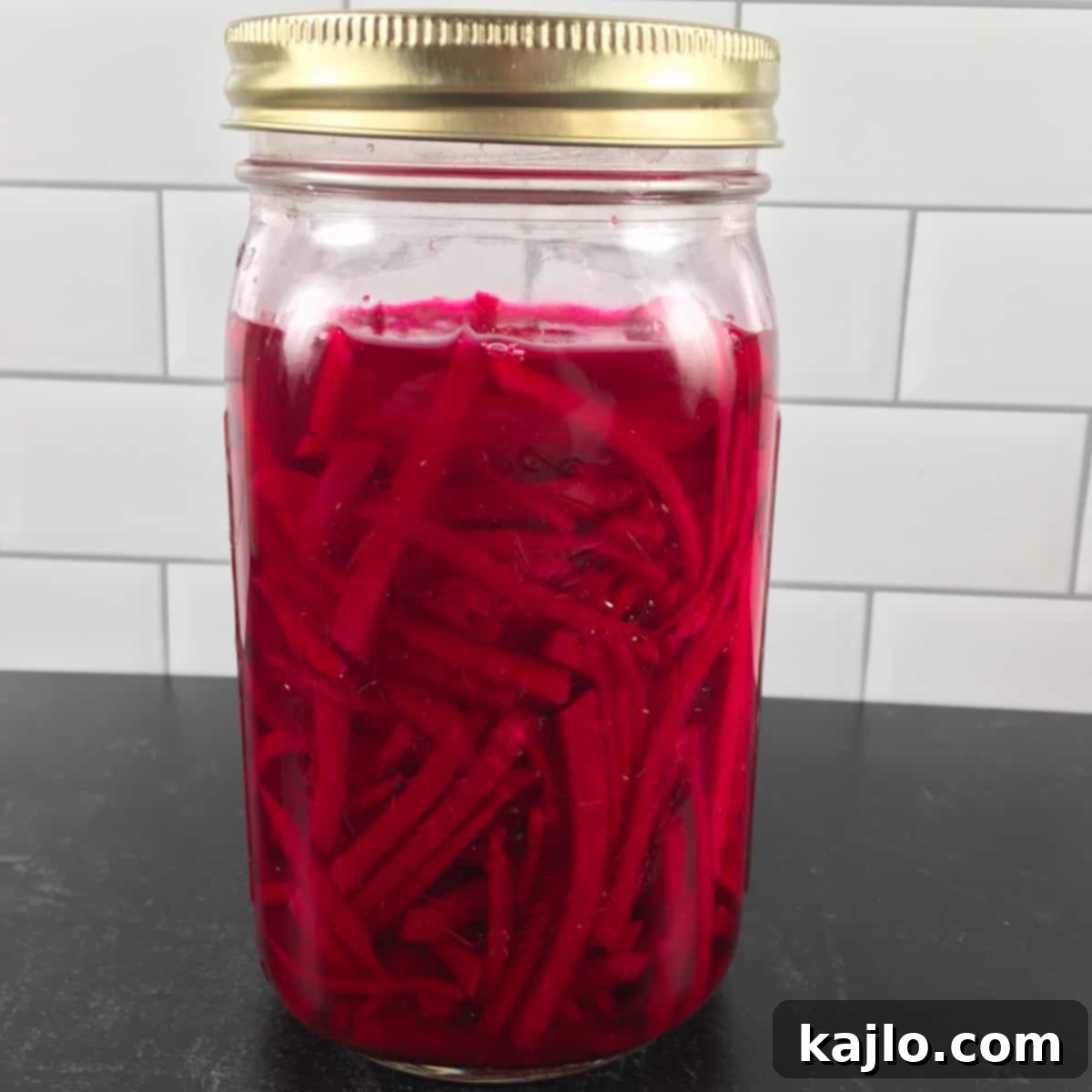
🌡️ Optimal Lebanese Pickle Storage
Once your pickles have completed their initial pickling phase, storing them correctly is crucial for maximizing their flavor and shelf life. Simply secure a regular lid and ring loosely on the glass jar and transfer it to your refrigerator. It’s vital to ensure that the turnips and beets remain completely submerged below the level of the liquid. This prevents exposure to air, which can lead to discoloration or spoilage.
A wonderful characteristic of these **Lebanese pickles** is that they truly get better with age. After a few days in the fridge, the sharp, raw turnip flavor begins to mellow, developing a more complex and enjoyable taste. The flavors continue to deepen and harmonize, making them an even more delightful condiment. These homemade pickles will happily last in your refrigerator for 1-2 months, and in my humble opinion, their taste profile only improves over time.
📋 Lebanese Pickles Nutritional Information
How many calories are in Lebanese pickles? A single serving of **Lebanese pickled turnips**, specifically 1/12 of the vegetables in the jar (without the brine), contains approximately 8 calories, 1.3 grams of net carbohydrates, and 0 grams of protein. These numbers highlight their role as a low-calorie, low-carb condiment that can enhance your meals without significantly impacting your nutritional intake.
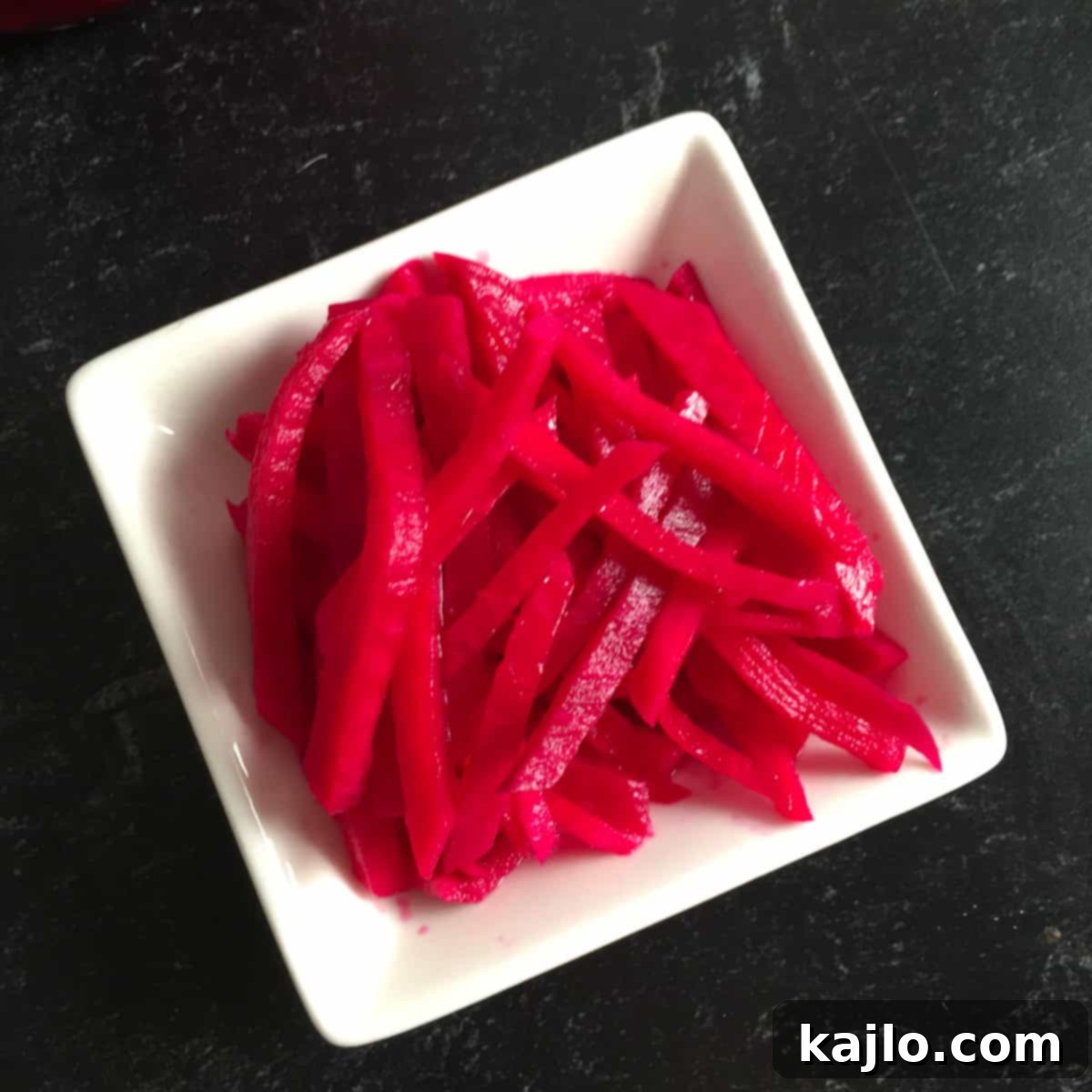
Frequently Asked Questions About Lebanese Pickles
Where can I buy Lebanese pickles if I don’t want to make them?
If you prefer to purchase ready-made Lebanese pickles, you can often find them at Middle Eastern grocery stores or specialty food markets. Online retailers like Amazon also offer options such as Ziyad Arabic Pickled Turnips or Al Dayaa Middle Eastern Pickled Turnips. Be sure to check reviews to find a brand that suits your taste.
What do Middle Eastern pickles taste like? Are they sweet?
Middle Eastern pickles, particularly the pink Lebanese variety, are primarily characterized by a vibrant salty and tangy flavor profile. They are not typically sweet; instead, they offer a crisp, sharp zest that provides a wonderful contrast to richer foods. While some may detect a subtle, natural sweetness from the beets, the predominant flavors are undeniably savory and acidic, making them an excellent palate cleanser and flavor enhancer.
Is there a lot of salt in pickles?
Yes, pickles, by their very nature, tend to contain a significant amount of salt, which is crucial for both their flavor and preservation. However, it’s important to note that much of this salt remains in the brine itself, which is typically not consumed directly. If you are monitoring your sodium intake, you can reduce the saltiness of the pickles by draining them thoroughly and rinsing them under cold water before eating. Keep in mind that rinsing might also diminish some of their intense flavor.
Why is vinegar added to pickles?
Vinegar plays a dual role in pickling: it adds a crucial element of acidity to the brine, which is responsible for the pickles’ characteristic tangy flavor, and it acts as a powerful natural preservative. In quick pickle recipes like this one, vinegar accelerates the pickling process, allowing vegetables to become deliciously tangy and ready to eat much faster than traditional slow fermentation methods that rely solely on salt.
Are Lebanese pickles healthy?
Lebanese shawarma pickles can certainly be a healthy addition to many diets. As a produce-packed condiment, they offer a delicious way to incorporate more vegetables, along with beneficial fiber and vitamins, into your meals. For individuals not on a strict low-sodium diet, these pickles can be a nutritious and flavorful food to enjoy, adding zest and variety to your culinary repertoire. However, those with sodium restrictions should consume them in moderation or rinse them well.
👩🏻🍳 Explore More Delicious Pickle Recipes
If you’ve enjoyed the process of making these vibrant **pink pickled turnips**, you might be eager to explore other exciting fruit and vegetable pickle recipes. Expanding your pickling skills is a fantastic way to enjoy seasonal produce year-round and add unique flavors to your meals. Here are a few more recipes to inspire your next kitchen adventure:
- Refrigerator Dill Pickles (No Sugar): A classic for a reason! These easy dill pickles are crisp, tangy, and require no cooking, making them perfect for beginners and seasoned picklers alike.
- Fermented Red Cabbage Sauerkraut: Dive into the world of traditional fermentation with this gut-healthy sauerkraut. Red cabbage offers a beautiful color and a slightly different flavor profile than its green counterpart.
- Fermented Lemons: A unique and incredibly versatile condiment, preserved lemons add an intense, salty, and bright citrus flavor to stews, salads, marinades, and more.
Each of these recipes offers a distinct flavor and texture, proving just how diverse and rewarding the world of homemade pickles can be. Enjoy experimenting and adding these delightful condiments to your culinary creations!
Watch How to Make It!
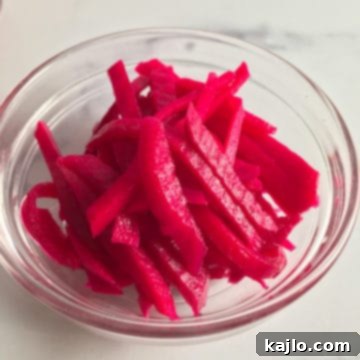
Lebanese Pickles Recipe (Middle Eastern Pink Pickled Turnips for Shawarma!)
Summer Yule
2 votes
Print Recipe
Pin Recipe
20
minutes
0
minutes
20
minutes
Side Dish, Slow Food DIY
Lebanese, Middle Eastern
12
8
kcal
Ingredients
-
10
ounces
peeled turnips
(283 grams) -
3
ounces
peeled beets
(85 grams) -
1
clove
garlic, peeled -
2
cups
water -
⅔
cup
white vinegar -
2
tablespoons
pickling salt or finely ground sea salt
(not iodized salt)
Love this recipe?
Please leave a comment below 😊
Instructions
- Important! Please read the post accompanying this recipe before you begin. It contains essential equipment information that you do not want to miss.
- Peel the beets and turnips and slice them into very thin batons (matchsticks). I recommend cutting them small enough where they practically look shredded. Smash a clove of garlic.
- Set the veggies aside while you prepare the brine.
- Put the water, white vinegar, and sea salt in a small saucepan on the stovetop. Dissolve the salt over medium heat, stirring occasionally. Allow the brine to cool for a few minutes.
- Pack the prepared veggies (including the garlic) into a clean wide-mouth quart jar. The veggies should be below the shoulders of the jar. If they don’t fit, they weren’t cut small enough.
- Pour the liquid over the veggies in the jar and place the jar weight in the jar. You may not use all of the brine- this is fine.
- Press the jar weight down if needed to submerge the veggies. The veggies should be completely below the level of the liquid. Both the liquid and the jar weight should be below the lip of the jar.
- Put the airlock lid on the jar. You may need to add water to the lid, depending on the type of lid you have.
- Leave the jar at room temperature (approximately 70°F/21°C) to pickle for 3 days. After that, put the regular lid loosely on the jar and place it in the fridge.
- Lebanese pickles mellow out and becomes better with age after a few days in the fridge. The pickles will last in the fridge for 1-2 months, and they just get better and better, IMVHO. Make sure the veggies stay beneath the level of the liquid.
Save this Recipe
Saved!
Equipment
-
Peeler -
Knife -
Wide-Mouth Quart Jar -
Fermenting Kit
Notes
💭 Expert Tips from Dietitian Summer Yule
This is a level 1 recipe (may help support fat loss).
Think of low and moderate-carb veggies as your BFF if your goal is weight loss. These pickles are a nice way to add some extra zing to meals and you get more veggies and prebiotic fiber in.
As mentioned above, we prefer the flavor of shawarma pickles after several days in the fridge. They’re also great on a salad, grain bowl, or as a burger topping!
Since we are using a lot of salt, this recipe is not appropriate for those on low-sodium diets. You will consume less salt than is used in the recipe if you drain the brine from the veggies prior to eating.
Rinsing the pickles decreases the sodium level even more. Unfortunately, you’ll also lose some flavor. If you’ve naturally fermented the beets and turnips (with just salt), you’ll lose some of the beneficial probiotics as well.
Nutrition information is for
1/12 of the vegetables in the jar, without the brine.
nutrition info disclaimer
All recipes on this website may or may not be appropriate for you, depending on your medical needs and personal preferences. Consult with a registered dietitian or your physician if you need help determining the dietary pattern that may be best for you.
The nutrition information is an estimate provided as a courtesy. It will differ depending on the specific brands and ingredients that you use. Calorie information on food labels may be inaccurate, so please don’t sweat the numbers too much.
“To taste” means to your preferences, which may have to be visual to follow food safety rules. Please don’t eat undercooked food x
Nutrition
Calories:
8
kcal
Carbohydrates:
1.8
g
Protein:
0.3
g
Potassium:
54.3
mg
Fiber:
0.5
g
Vitamin C:
8.6
% DV
Calcium:
1.2
% DV
Iron:
0.5
% DV
lebanese pickled turnips, lebanese pickles, lebanese pickles recipe, middle eastern pickles, middle eastern pickles recipe, pickled turnips, pickles for shawarma, pink pickles, pink pickles recipe, shawarma pickles
Shop our cookbook!
Easy Air Fryer Recipes for One
Burning your air fryer recipes?
Here’s how to fix it!
Join our community! Subscribe for all of the latest and greatest recipes, and follow me on Facebook, Pinterest, Instagram, and YouTube!
